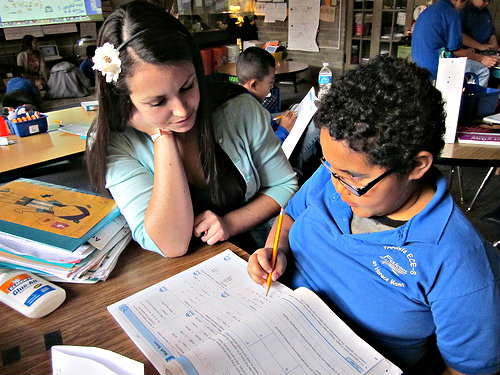
 For years, Trevista K-through-8 school in Denver posted some of the lowest scores in the state. So last spring it was ordered to make dramatic changes - a process called a school turnaround.
For years, Trevista K-through-8 school in Denver posted some of the lowest scores in the state. So last spring it was ordered to make dramatic changes - a process called a school turnaround.
CPR chronicled the final tumultuous few months before the big shake-up. A new principal hired a new slate of teachers and put into motion changes she hopes will lift the school to higher heights. Today we take a look at progress so far.
Here is a transcript of CPR education reporter Jenny Brundin’s report.
Click here for all the stories in our Trevista series
Reporter Jenny Brundin: Principal La Dawn Baity took the job at Trevista with boundless optimism. And while she’s always cheerful, she’s not naïve. The school has lots of challenges. Ninety-seven percent of the school’s children live in poverty. Their needs are great.
La Dawn Baity: We’re a little slower in some areas than I hope to be at this time and further along in other areas.
Reporter: The statistics were daunting. At the end of last year, just 16 percent of 4th graders were writing and reading at grade level. Just 11 percent of 7th graders were where they should be in math. Teachers tested all students in September so they could see what each child would need this year, and they made plans to offer extensive support in the classroom those who need it.
Baity: Where do we want kids to be by the end of the year? How are we going to make sure we make more than a year's growth for anybody that's more than a year below grade level?
Reporter: Baity knew the first few months, especially, could be rough-going. And they were. Behavior in the middle school was at times out of control. Several teachers quit. More than 20 percent of students are still “chronically absent.” But things are calmer now. There’s a host of school clubs like this choir….
Kids singing: “Hot, hot, hot, hot chocolate. I can’t get enough.”
Reporter: And for the first time in a while, a student council, not to mention their basketball teams finally get to compete against other middle schools. Baity recognizes these help inspire students. And then there are the extra steps she’s taking to intensify the academic instruction for Trevista’s students who need help, which is most of them. Things like focusing on math, reading or both before the school day starts.
Math tutor: Sixteen. So what is our perimeter?
Students: Sixteen!
Math tutor: Sixteen….
Students: Meters!
Math tutor: Meters right? Remember? We always have to tell what we’re measuring.
Reporter: Kids like 4th grader Sergio Hernandez arrive early. He’ll get a taste of what’ll be in his math class later in the day. Sergio is a stocky kid, with curly dark hair and glasses. Last year he says:
Sergio Hernandez: I didn’t really get math that much.
Reporter: This year, he’s starting to “get it” – with a lot of help. Baity has enlisted volunteers from a group called City Year - it’s a national service organization for young people who work in struggling schools. They help run these early morning “college academies” as they are called. Sergio’s math teacher Rachel Rosenberg, says she sees the impact of the morning sessions later in the day.
Rachel Rosenberg: I think that it helps build vocabulary for them and it also builds their confidence that they’ve seen parts of it before, so they can share their thinking and take risks without feeling like they have no background knowledge to start with.
Reporter: Rosenberg’s goal for Sergio is that he needs to score at least a 72 percent on his math unit tests. He’s progressing.
Rosenberg: So if we look at Sergio….Sergio’s right here….
Reporter: Rosenberg is looking at a detailed spread sheet. This is how teachers track whether each student is gaining ground. She makes sure he’s meeting his 6-week targets.
Rosenberg: He’s right along to even we’re thinking being a 76% kid…..
Reporter 8: And students aren’t just getting the extra half -hour each morning.
Teacher aide: How did you figure that out? Why didn’t you multiply? Why didn’t you divide? Why did you choose subtraction?
Hernandez: Cuz it is getting littler .
Reporter: Baity is using a federal grant Trevista got for being a “turn around” school to add a teacher’s aide to most classrooms. And volunteers- like this one - also help during the school day. She’ll make sure Sergio understands how to arrive at solutions to math problems.
Teacher aide: Check your math on this one. I just noticed something.
Reporter: And there’s more help a few minutes later when Sergio joins a group run by teacher Rachel Rosenberg.
Rosenberg: 1,2, 3, 4, 5. Now can I do this. Can I put this one over there?
Hernandez: No.
Rosenberg: Why not, Sergio?
Rosenberg: Because it would be making a new row.
Rosenberg: That’s so smart!
Reporter: Though teachers rely heavily on test data to get kids the extra help they need -- data hasn’t been able to tell them everything. Based on the reading scores of some of the older kids – teachers thought they’d be able to read novels or chapter books. But Principal Baity says they found that many kids didn’t have the attention for books that long.
Baity: The span of time they were willing to spend reading wasn’t getting them through entire books.
Reporter: So they had to start more simply- getting students to read short, non-fiction pieces on a computer and answering questions at the end. That’s in addition to their regular Language Arts classes. Baity says students like the immediate feedback.
Baity: And so we're finding actually that that's been highly motivating to get kids to read more and read more closely and carefully.
Reporter: They plan to gradually boost the amount of time each student is reading. And so it will go at Trevista. If something doesn’t work, readjust to get it right. Jenny Brundin, Colorado Public Radio News.









